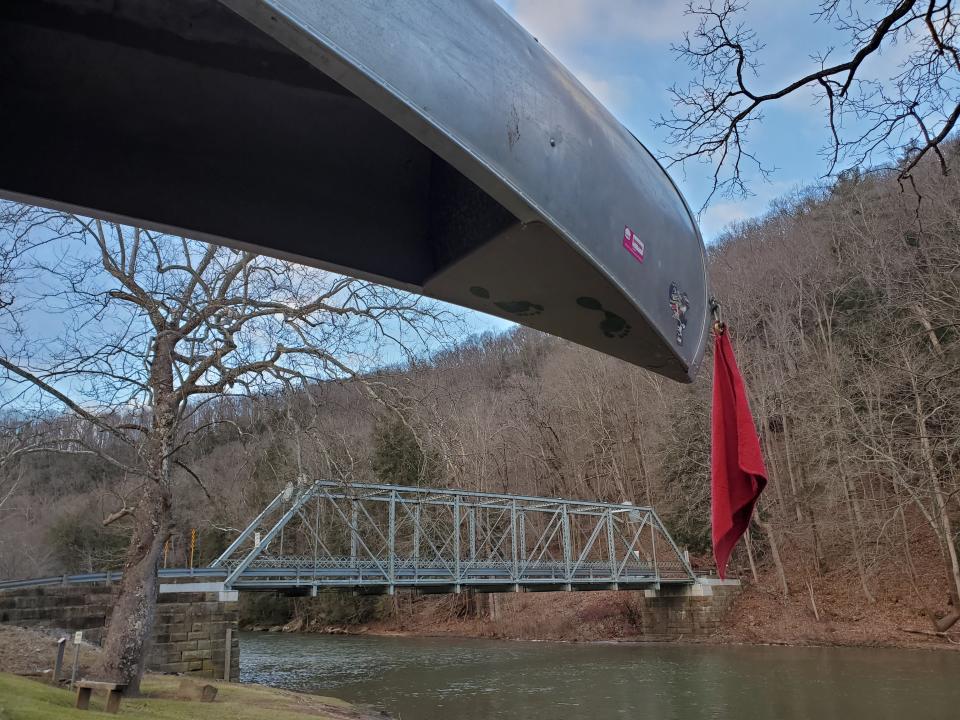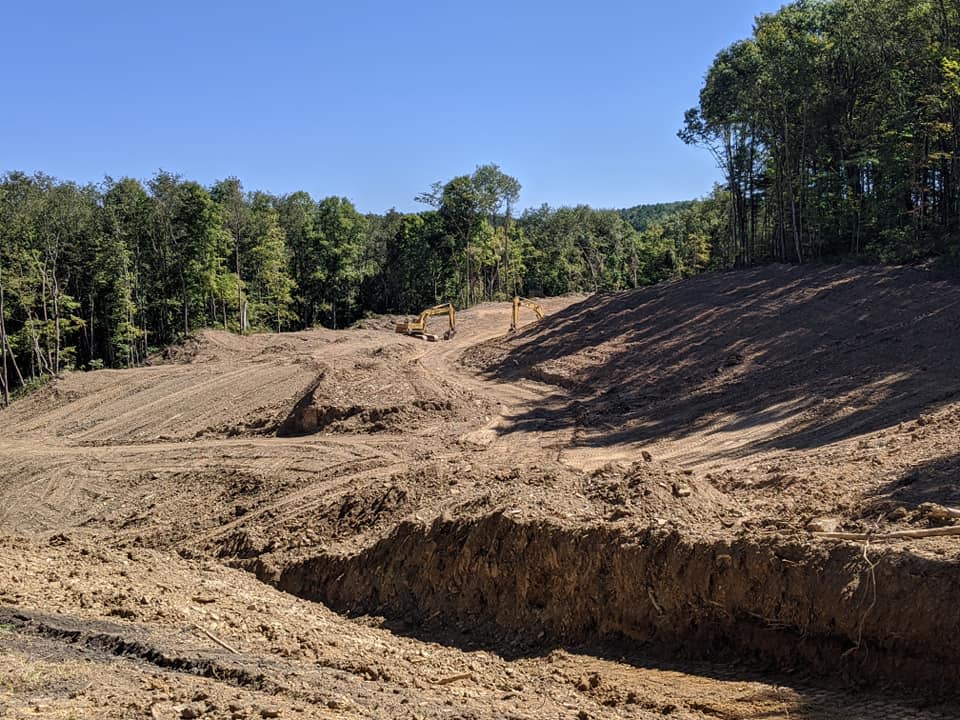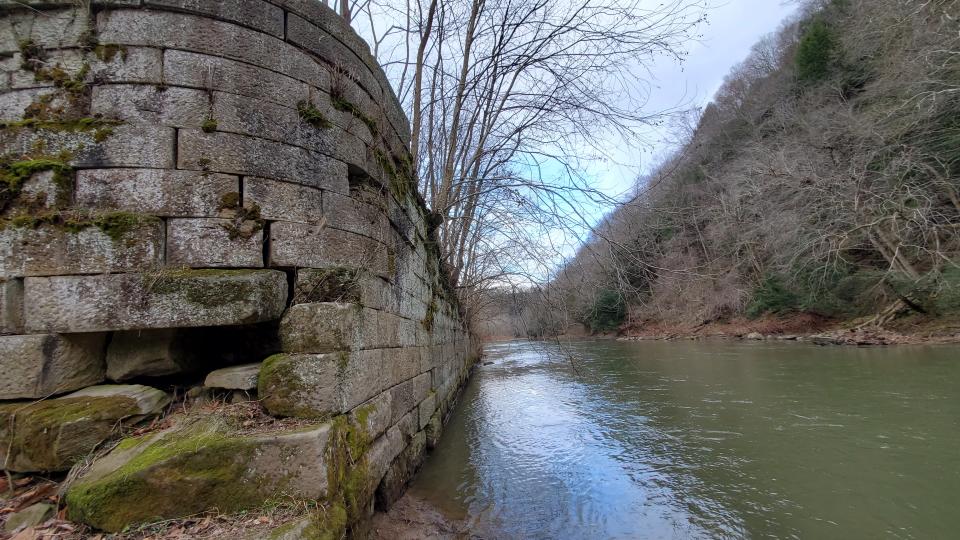Hosts, ghosts, nature, history and a dead desperado – Beaver Creek State Park has it all
EAST LIVERPOOL − The park hosts and their dogs were there to welcome me when I pulled up to my campsite at Beaver Creek State Park. Not by design. It just happened. Pretty much like everything else on this three-day road trip through Eastern Ohio.
The couple − they told me their names but I promptly forgot them − weren’t on duty. Camp hosts don’t work in the winter. They just happened to be out walking their dogs on a drizzly February morning.
Like the man I met in Perrysville a week earlier, they told me about the park’s historical village, the intact remnants of canal locks and 12 miles of hiking trails − much of which follow Little Beaver Creek.

“There’s a group hike tomorrow morning,” the woman told me.
I regret I didn’t stick around for the hike. I had a lot of ground to cover in three days and only planned to spend Friday and Friday night at the 2,700-acre state park. I later learned through the park’s Facebook page that 78 people came out for the hike.
I asked about the wide expanse of saplings planted on hillsides around the campground. They were shrouded in plastic tubes to protect them from the deer.
The park host couple told me it was reclamation land from coal mining.
More: Almost missing the shortest covered bridge in the country
About the saplings shrouded in plastic
I later contacted park manager Karl Mattern, who explained it in more detail.
“Beaver Creek State Park contained the remnants of pre-law open pit strip mining for coal,” Mattern wrote in an email. “These highwalls and strip pits were created by digging in the land following a vein of coal, removing the coal, and piling up the unwanted rock and earthen spoils on the downhill side. Strip mines scar the land by leaving steep drop-offs and stagnant pools of water, which can be a vector for disease, and interrupt the natural watercourse.

"Reclamation projects try to fix these scars by reclaiming the land as best as possible to its original contours, restoring the natural watercourse, eliminating stagnant pools of water and in the case of the reclamation project at Beaver Creek State Park, then reforesting the construction area by planting thousands of trees.”
Reclamation work started in 2020. The vast expanse of saplings in row upon row of white plastic tubes looks like some sort of alien landscape. Yet, you realize it’s quite an improvement compared to what it looked like before. For more than 70 years, Beaver Creek State Park campers gazed out over scarred earth. And felt the wrath of mosquitoes that bred in the stagnant pools.
The next generation of campers will look out over a forest of oak, black cherry, dogwood, sycamore, redbud and other species, including volunteer honey locust trees.
“Over 10,000 individual trees were planted,” Mattern said.

The ghost of little Gretchen wasn't to be found
That night, I would cap off a day of hiking and exploring the park’s historical sites with a stroll through the reclamation area. In all, I hiked nearly 10 miles Friday and Friday night.
Unfortunately, I only had time to explore one of the Sandy & Beaver Canal locks within the park boundaries − Gretchen’s Lock. The ghost of little Gretchen did not grace me with her presence. Had I been there in August, it might have been a different story.
As Chris Woodyard wrote in one of her “Haunted Ohio” books: “Gill Hans, the engineer who built the lock, brought his family over from Holland. His young daughter Gretchen pined for the Low Country until, weakened, she contracted malaria and died August 12, 1838, raving about going home. Distraught, Hans had Gretchen's coffin temporarily entombed in a vault within the lock's stonework until the family could return to Holland together.
"He made arrangements to sail; Gretchen's coffin was loaded onto the ship and the entire family sailed into oblivion. The ship went down in an Atlantic storm with all hands. Yet even death could not take Gretchen home. On the anniversary of her death, the young Dutch girl can be seen walking along the lock that bears her name.”
Just part of the lore of an ill-fated canel
After all the work that went into it, the Sandy & Beaver Canal carried a modest amount of boat traffic in the four years it was in operation. Regardless, on this road trip the canal served as one of the unexpected and remarkable connections across space, time, and among people I knew or would come to know.
Among that cast of characters were my friend Scott Freese and the stranger who stopped to talk to me in Perrysville. Both spoke of the virtues of Little Beaver Creek. I later contacted two of Ohio’s foremost authorities on stream health, Gregory Lipps and Brian Zimmerman. They had nothing but good things to say about it.
In an email, Lipps, Amphibian & Reptile Conservation Coordinator with Ohio State University’s Biodiversity Conservation Partnership, said: “Little Beaver Creek is empirically one of the highest quality watersheds in the entire state and is an important area for the conservation of the hellbender (salamander).
This is due in large part to the amount of intact riparian forests, many of which have been protected by state and local parks, land trusts, and landowners who value the creek. Having spent a lot of time in creeks all over the state, I can attest to the Little Beaver Creek Watershed being one of Ohio's greatest gems.”
Highest quality stream in Ohio
Zimmerman, OSU Research Associate and Rare and Endangered/Non-Game Fish Biologist, said: “Little Beaver Creek is certainly one of the highest quality stream systems in Ohio. I have fished this stream since I was in high school in the 1990s and have been monitoring this area for rare and or water quality-sensitive fish species since 2009. I do an annual fish snorkeling survey in the lower end of Little Beaver Creek near the Ohio River each fall and have documented quite a few species recolonizing the system from the Ohio River.
“From a hook and line fishing standpoint, Little Beaver Creek is an excellent smallmouth bass fishery and has runs of walleye, sauger, and white bass out of the Ohio River seasonally. Some of these more migratory species can be found in the deeper pools year-round. Little Beaver also has a good channel catfish population. I personally enjoy fishing for redhorse suckers as well and Little Beaver has all five species native to the Ohio River Basin.
"There are also good numbers of rock bass and some black crappie. I do get the occasional largemouth bass and have caught two spotted bass. These two are certainly the minority here though because Little Beaver is too rocky and fast flowing for these, those conditions are much more favorable for the smallmouth bass.”
River conditions for paddlers can be hit-or-miss. The Little Beaver has a reputation for being a great river to paddle but − like Clear Fork of the Mohican River, the lower Grand River, and similar streams − paddlers are advised to be patient and wait for windows of opportunity.
Paddlers should their homework
Park manager Mattern advised paddlers to do their homework before heading out to Little Beaver Creek: “High water periods can be very dangerous while low water can make the creek nearly impassable in some points, so the flow has to be just right for good water recreation. Water levels can be monitored by visiting americanwhitewater.org.”
Freese, some of my other paddling friends, and I will probably give it a try later this year.
One way or another, I plan to return to the state park. I still have plenty of trails to explore and things to see — including the place where Charles “Pretty Boy” Floyd retired from a life of crime. So to speak. An historical plaque marks the area where he was gunned down by the cops. He fled there after being spotted in the Village of Wellsville, which is about 12 miles south of the park.
Unintended side trip is yet another story
That became another bizarre connection on my road trip. I had not intended to visit Wellsville. But then, Floyd probably didn’t plan on stopping − for good − in a cornfield that would someday become part of Beaver Creek State Park.
Stay tuned.
Meanwhile, here’s a piece of Pretty Boy Floyd trivia. He hated his nickname, which one of his floozies had bestowed upon him. He preferred to be called Choc, after his favorite alcoholic concoction — Choctaw beer. Which was a regional “folk remedy” in Oklahoma made from basic beer ingredients plus fruit or anything else that could be fermented.
As reported by the Oklahoma Historical Society: “In the mid-1900s, when questioned about his choc beer, an Oklahoman said, ‘It won't hurt nobody ’cause fruit’s good for ya, but it'll make you drunker than a fool. Don't put snuff in it, that would kill a dog! As good as it is, everybody should have two or three glasses a day. My family always felt good’.”
This article originally appeared on Ashland Times Gazette: Beaver Creek State Park has it all - ghosts, hosts, history

